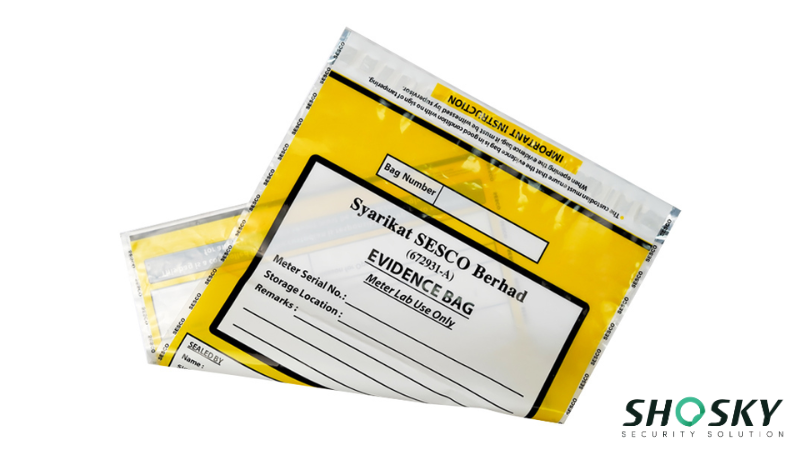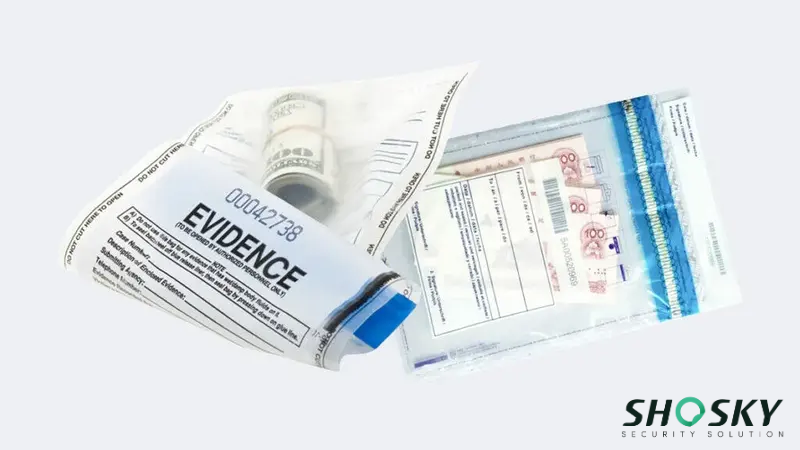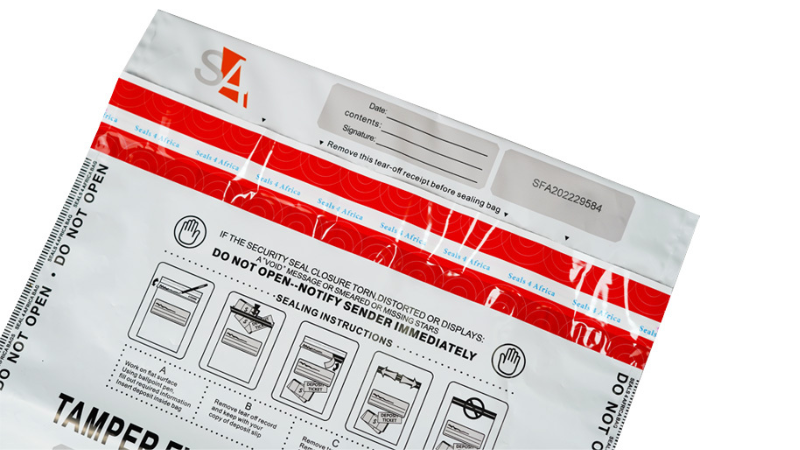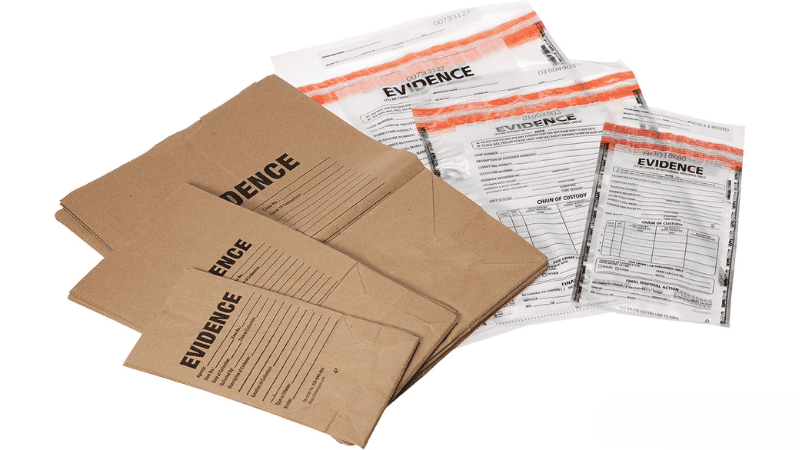The material of evidence packaging is part of the investigation. A study found that after analysis and repackaging, 95% of drug evidence packages had detectable drug residue on their exterior, even when repackaged into new bags. Paper bags allow samples to air dry, reducing moisture and mold risks. Plastic bags, while more durable and space-saving, can trap humidity and compromise evidence quality.
In this article, we’ll explore the key differences between paper and plastic evidence bags. We’ll look at how each affects storage, transport, contamination risks, and overall chain of custody.
What Are Evidence Bags and Why Do They Matter?

Evidence bags are specially designed containers used to store, protect, and transport items collected during a criminal investigation. These bags hold samples like clothing, blood, weapons, and drugs. The main goal is to prevent contamination, tampering, or loss. Whether made of paper or plastic, each type of bag is chosen based on the kind of evidence being collected and its storage needs.
One of the most important reasons evidence bags matter is the chain of custody. This refers to the documented process that tracks the movement of evidence from the crime scene to the courtroom. If the packaging is not sealed, labeled, or handled correctly, the integrity of the evidence is at risk.
In court, even strong physical evidence can be thrown out if its chain of custody is broken or unclear. Secure packaging using evidence tape and proper labeling helps maintain trust in the investigation process.
Police officers use them at crime scenes. Forensic laboratories use them to store and test samples. Attorneys present them in court as proof of the crime. Every step, from collection to storage, relies on proper evidence packaging to ensure that the truth is preserved and justice can be served.
Paper Evidence Bags – Features and Advantages

Paper evidence bags are a staple in many forensic settings due to their simplicity, reliability, and practicality. Their structure makes them suitable for a wide range of evidence types. Here are their key features and benefits:
Breathability
Paper is porous, allowing trapped moisture to escape. This makes paper bags ideal for biological evidence like blood, hair, and plant matter, especially when mold or sample degradation is a concern.
Tamper-Evidence
Paper bags can be securely sealed using tamper-evident bag tape or staples. They’re easy to mark and date, helping investigators verify that seals remain intact through each transfer.
Labeling and Documentation
The writable surface allows for quick and clear evidence logging. They’re also compatible with chain of custody forms, barcodes, and evidence tape, simplifying the documentation process.

Eco-Friendly Material
Many paper bags are made from recycled or biodegradable materials. This makes them a greener choice, aligning with growing efforts toward sustainable policing and forensic practices.
Cost-Effective
Paper evidence bags have lower production costs than high-performance plastic alternatives. They offer a budget-friendly solution for departments that need reliable tools without stretching procurement budgets.
Paper evidence bags remain a trusted choice in many crime scene investigations and lab settings. They are best for powders, dry evidence, trace materials, narcotics, and DNA samples. They’re especially useful in drug investigations, environmental forensics, and field collection of delicate samples.
Plastic Evidence Bags – Features and Advantages

Plastic evidence bags offer a range of benefits, especially when protection from moisture and durability are top priorities. Their design supports the secure handling and preservation of a variety of evidence types. Here’s a closer look at their main features:
Moisture and Contaminant Resistance
Plastic bags can be airtight and watertight when sealed properly. This prevents cross-contamination during transit or storage, keeping evidence safe from external elements.
Superior Durability
They are tear-resistant and puncture-proof. Plastic bags can withstand rough handling, transportation, and harsh environments without compromising the evidence inside.
Tamper-Evident Closures
Many plastic bags use adhesive seals or built-in zip locks with void labels. Any change in the seal clearly alerts investigators to unauthorized access or tampering.

Visibility and Inspection
The transparent construction allows quick visual checks without opening the bag. This feature speeds up cataloging and supports clear court presentations.
Long-Term Preservation
Plastic protects delicate items like electronics, metal objects, and firearms from humidity and oxygen exposure. It’s ideal for evidence that requires long-term storage while maintaining the chain of custody.
Advanced Security Features
Some plastic bags come with serialized barcodes, RFID chips, or UV tags. These enable digital tracking within forensic evidence management systems for added security.
Plastic bags are suitable for wet evidence, sharp objects, digital devices, tools, and hazardous items. They are commonly used in post-mortem investigations, cybercrime cases, and laboratory testing. While paper bags are ideal for certain types of samples, plastic evidence bags offer unmatched protection when strength, moisture control, and long-term storage are essential.
Paper vs. Plastic Evidence Bags: Material Comparison

Choosing between paper and plastic evidence bags depends largely on the nature of the evidence and the conditions under which it will be stored and transported. Below is a detailed comparison to help guide proper selection based on the specific needs of an investigation:
By carefully considering the strengths and limitations of each material, investigators can make informed decisions that enhance evidence preservation and reduce the risk of contamination. Selecting the right type of bag not only safeguards the integrity of the evidence but also supports the overall success of the forensic process.
Choosing the Right Evidence Bag: Factors to Consider
Selecting the correct evidence bag is critical to preserving the integrity, reliability, and admissibility of evidence in any investigation. Different types of evidence carry different risks, including contamination, degradation, and legal challenges if improperly handled.
Risks of Improper Evidence Packaging

Different types of evidence have different risks involved, such as contamination or loss. Improper handling can lead to:
- Contamination: Moisture trapped in plastic bags can degrade biological samples, leading to false negatives or unreliable DNA analysis. Cross-contamination risks increase if powders or drugs spill due to inadequate sealing.
- Loss of Evidence Integrity: Broken seals or damaged bags undermine the chain of custody and can cause evidence to be dismissed in court.
- Legal Challenges: Inaccurate documentation, unclear labeling, or compromised packaging open doors for defense attorneys to challenge the validity of the evidence.
Understanding the risk means matching the packaging to the potential consequences of failure. For high-risk evidence, such as blood samples or trace evidence, paper bags with proper air circulation and tamper-evident seals may be the safest choice.
3 Key Factors to Consider
To prevent these issues, forensic teams must consider factors such as evidence type, storage conditions, and transport duration when making packaging decisions.

1. Evidence Type
The nature of the evidence is the first and most vital consideration. Biological samples like blood or hair benefit from breathable paper bags that allow moisture to escape, preventing mold growth.
Dry items such as powders, drugs, and trace materials also work well in paper bags. Conversely, wet evidence, sharp objects, electronic devices, or metal items require plastic bags for protection against moisture, punctures, and environmental damage.
2. Storage Conditions
Consider where and how long the evidence will be stored. If evidence needs long-term storage, plastic bags provide superior protection against humidity and air exposure. However, paper bags are better for short-term storage of biological evidence where air drying is vital.
Environmental factors like temperature fluctuations and exposure to sunlight or chemicals can influence the choice, favoring plastic for harsher conditions.
3. Transport Duration

The time and method of transportation affect packaging choice. Evidence moved quickly to the lab may tolerate simpler packaging, but evidence in transit for longer periods or via multiple handlers requires more robust bags with tamper-evident seals. Plastic bags excel in protecting evidence from accidental spills or weather during extended transport.
Choosing the right evidence bag is essential to protecting the integrity and admissibility of evidence. By matching the packaging to the type of evidence and considering factors like storage and transport, forensic teams can reduce risks of contamination, damage, and legal disputes, ensuring the evidence holds up in court.
Right Packaging to Maintain the Chain of Custody
Maintaining the chain of custody is essential to preserving the integrity and reliability of evidence throughout an investigation.
Sealing, Documenting, and Signing Processes
Once evidence is collected, it must be sealed tightly using tamper-evident tape, adhesive seals, or staples. This prevents unauthorized access and clearly shows if the package has been opened. Investigators then document details like the date, time, and their signature directly on the packaging or associated evidence tape.

This detailed record serves as a transparent log of who handled the evidence, when, and under what circumstances. Clear documentation supports the legal chain of custody and prevents challenges to the evidence’s authenticity in court.
Integrating Evidence, Barcodes, and Tracking Systems
Modern forensic practices increasingly rely on integrating evidence bags with barcodes or RFID tags to improve accuracy and accountability. Each evidence bag can be labeled with a unique barcode, linking physical samples to digital tracking systems.
During collection, transport, and storage, scanning these codes updates the evidence status in real time. This reduces human error from manual paperwork and offers investigators and laboratory staff an efficient way to manage large volumes of evidence. Digital tracking systems enhance the security of the chain of custody by providing clear audit trails that are difficult to falsify or lose.
Preventing Tampering and Human Error During Transfers
The use of tamper-evident packaging combined with standardized transfer procedures ensures any unauthorized access is immediately obvious. Packaging with void labels or security tape provides visual cues if bags have been opened.

Furthermore, strict protocols for transferring evidence, such as verifying seal integrity, signing over custody, and conducting inventory checks, help minimize mistakes. Proper training of all personnel involved in evidence handling reinforces these measures and safeguards the chain of custody from start to finish.
FAQs
When should I use a paper evidence bag instead of plastic?
Use paper evidence bags for biological evidence like blood, hair, or plant samples that need to air dry. Paper’s breathability helps prevent mold and degradation
Are plastic evidence bags always tamper-proof?
No, plastic evidence bags are not completely tamper-proof, but many come with tamper-evident features like adhesive seals, zip locks, or void labels that reveal unauthorized access.
Can paper evidence bags hold wet samples?
Paper bags are generally not suitable for wet samples because they absorb moisture and can weaken or degrade. Wet evidence is better stored in plastic bags that provide airtight, moisture-resistant protection to preserve the sample and prevent contamination.
Conclusion
Both paper and plastic evidence bags play essential roles in maintaining evidence security. Choosing the right material depends on the type of evidence, the demands of the chain of custody, and environmental factors. It is important to balance legal compliance, preserve evidence integrity, and consider sustainability when selecting packaging materials.
Customize Your Evidence Bags with Shosky Security Today!
At Shosky Security, we specialize in providing high-quality, tamper-evident evidence bags that meet strict chain of custody requirements. Contact us now, and our expert team will guide you in selecting packaging materials tailored to your specific needs.

